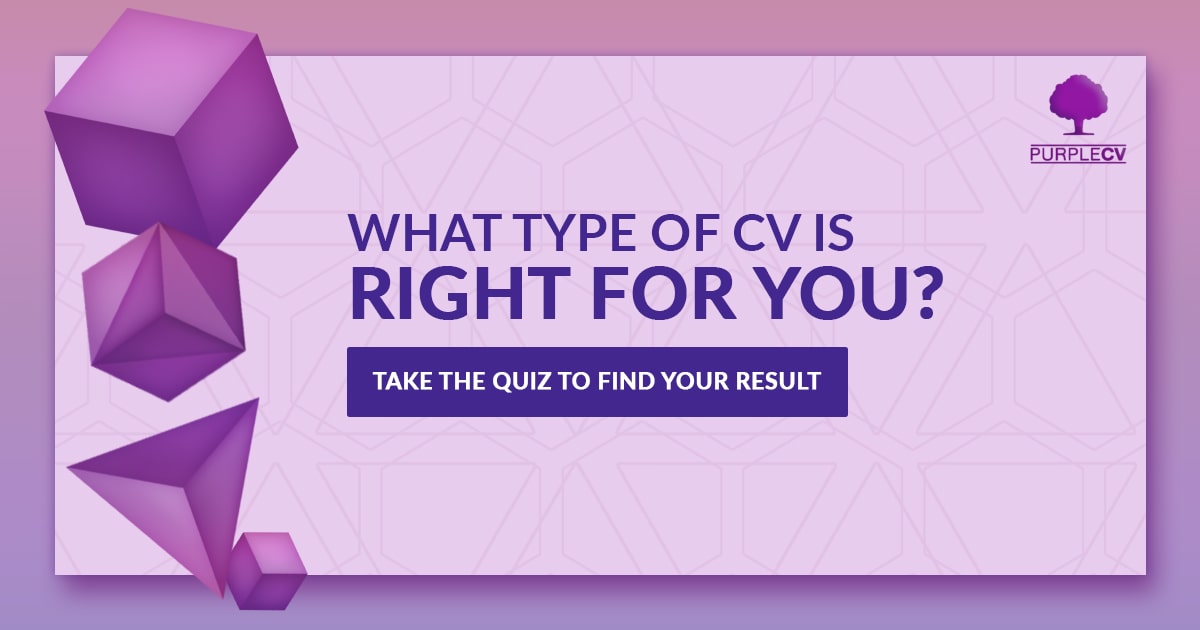Journalism CV Tips: How To Write A Journalist CV + Example
Just as your articles need to grab readers’ attention straightaway, any journalism CV must do that too… In this guide... Read more...

Planning your CV might seem simple, but if you don’t know the different CV types you can use, you could be selling yourself short.
There is no one-size-fits-all CV. Each candidate – and every application – needs a tailored approach.
Moreover, the type of CV format and layout you choose can have a huge impact on how an employer views your application.
In this blog, we’ll walk you through the different types of CV to choose from. We’ve even put together a quiz to help you find the format that’ll make your CV shine.
Take our quiz below to find out which type of CV is right for you!
Jump to quizThere are three common CV types that will fit most industries:
But what do these different types of CV mean? Read on to find out…
A functional (or skills-based) CV puts the focus on your skills and achievements, rather than your work history.
This type of CV starts with a list of skills and achievements from your personal and professional life. Follow that up with a brief section featuring your education, work experience or employment details. Any formal qualifications should be noted in this section, too.
A functional CV is the best of the CV types if you’re looking to change your career, and don’t have prior experience with the job’s responsibilities.
A functional CV will put your valuable transferable skills at the forefront. This means employers can focus on what makes you a good fit for the role – not what you’re lacking.
Similarly, if you’ve taken time out from the workplace, a skills-based CV may serve you better than chronological CV types, where career breaks are more evident.
If you’re writing a functional type of CV, take the time to read the job description carefully. What desired skills are flagged up? How can you demonstrate these succinctly on your CV?
Remember: recruiters and hiring managers are almost always short of time. Careers experts recommend that you say your most important information on the first half of your page.
If your skills aren’t your strongest asset, consider one of the other CV types.
A functional career change CV will go well with a well-structured cover letter, which is why we have written about how to write a career change cover letter.
This is one of the most commonly used CV types. Typically, chronological CVs will include a personal statement with your career objectives, followed by your employment history in reverse-chronological order.
You would then detail any relevant job qualifications, followed by your hobbies and interests.
Education typically sits above employment history- at least for those new to the job market.
However, if you’re further along in your professional life, exam results and degree qualifications may no longer carry the same weight.
Traditional CV types like the chronological CV are popular with employers because they can see your career progression. If you have worked in the same sector for a while and want to continue to do so, this is the best CV format for you.
Of course, with a functional CV, there is no hiding from large gaps between roles. That doesn’t mean you can’t use the chronological format – but explain why the gap is there on your cover letter, if not on the CV itself.
If you like aspects of both of the previous CV types, a combined CV could be the answer.
It’s a mixture of the features of both functional and chronological CVs, and can be the best of both worlds – but only if it’s handled with care.
This type of CV consists of a profile, then a brief skills section. Follow that up with your career history, detailing responsibilities and achievements for each role.
By its nature, a combined CV will often end up longer than a skills-based or chronological CV. However, remember the importance of brevity – most recruiters will only look at your document for six seconds.
Also, if you’re struggling to pull together skills and achievements from previous roles, combined types of CVs are likely to do more harm than good.
That said, for those with a very strong career path and achievements the combined CV is ideal. It’s a great way to show your transferable skills, without tying you to a specific sector.
Not sure which type of CV is right for you? Take our quiz below to find out!
At PurpleCV, we know that you’re not a template. Every candidate has different strengths and career goals. The different types of CV are your chance to highlight the most important experience for you.
If you’re still unsure which types of CV you might need, or want some help creating a different type of CV than what you’re used to, our expert writers are here to help.
We’ll craft a unique CV to your skills so you can take the next step in your career, wherever you want to go.
